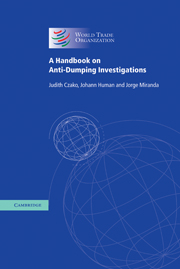PART II - DUMPING MARGIN CALCULATIONS
Published online by Cambridge University Press: 05 March 2012
Summary
INTRODUCTION
Although the AD Agreement contains some guidance on the methodologies to be applied in calculating the margin of dumping, it does not provide comprehensive and detailed provisions to deal with all the issues involved. In some instances, the AD Agreement provides for different options and leaves it to investigating authorities to decide which methodology to apply. In some of those instances where the AD Agreement does not provide clear guidance, the practice of Members differs to a greater or lesser degree. An effort has been made to refer to the different practices of Members where the authors were aware of such practices. It is therefore not claimed that these references are complete, and is done without any reference to the WTO compatibility, or not, of such practices.
In this Part, the calculation of the margin of dumping is illustrated through a series of simulations. These simulations are built in a gradual, step-by-step fashion, starting with relatively simple examples first, followed by others of increasing complexity. The simulations are fully integrated with one another. This means that both the simple and the more complex cases are built around the same basic facts. The discussion of issues is therefore incremental, rather than self-contained.
The Flow Charts, including the Advanced Flow Chart, at the end of this Part, illustrate the different steps of the process graphically.
In those instances where two or more distinct methodologies are possible, the methodologies applied in the simulations should not be interpreted as expressing a preference for such methodologies and are merely used as illustration.
- Type
- Chapter
- Information
- A Handbook on Anti-Dumping Investigations , pp. 97 - 224Publisher: Cambridge University PressPrint publication year: 2003



